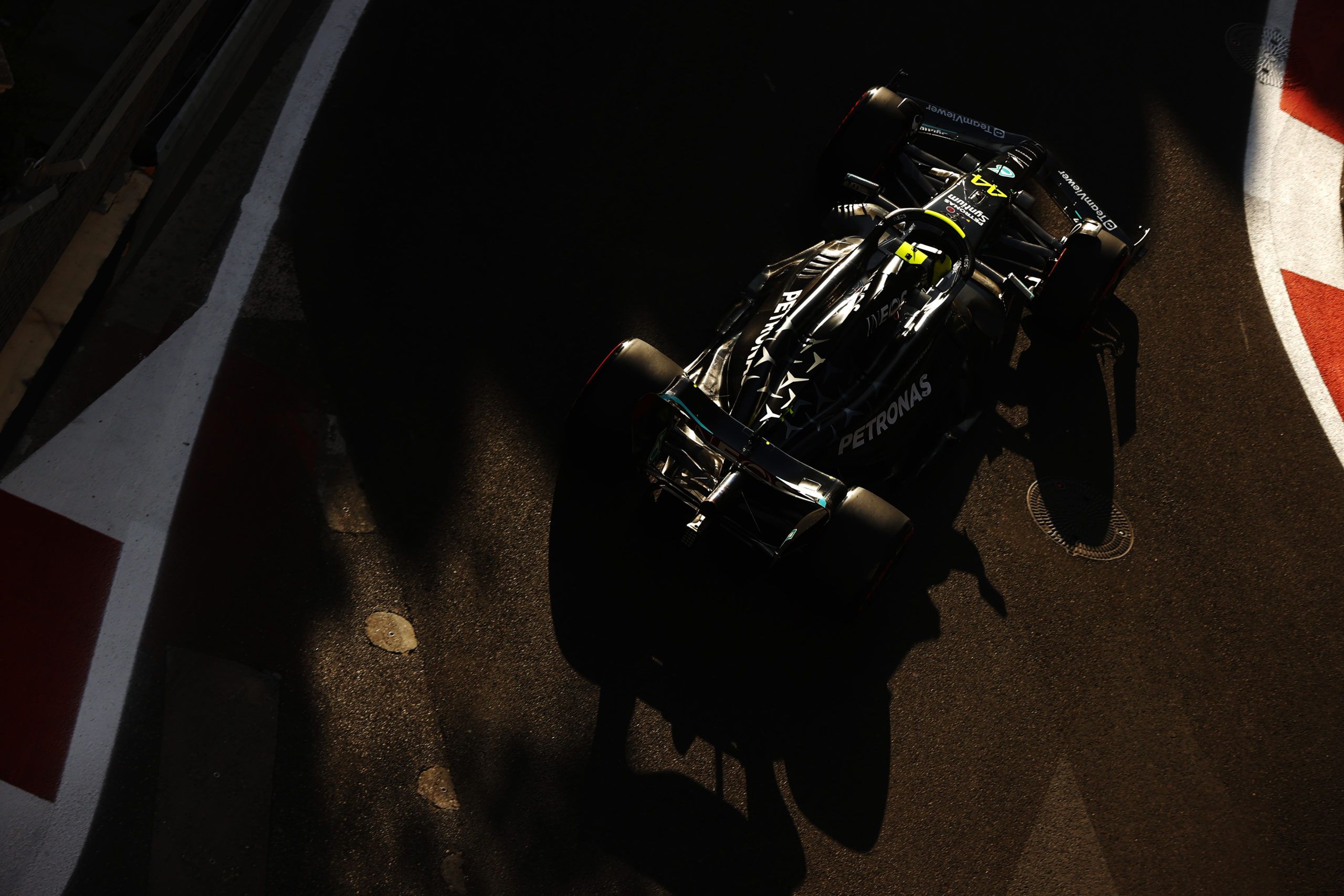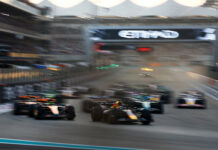Mercedes has compiled the process of a F1 team bringing an update as they go by the different departments to get them ready.
After the Imola washout, Mercedes has shifted its focus on F1 Monaco GP this weekend where they will introduce its first chunk of a big update which they were to try out during the Emilia Romagna GP but couldn’t do it due to cancellation.
It is only Wednesday, but photos of a new sidepod design has popped up already by onlookers. Not everyone has been so lucky considering the closed gates of the Mercedes garage, as they are trying every last bit for the new parts to be not caught on camera.
The design is a slight shift from its zero pod which seemingly hasn’t worked. There are new suspension parts too as they kick-off their journey towards the top. Ahead of the F1 weekend, Mercedes released the process of how an update is brought about.
The different departments at the base have to work in close quarters keeping everyone in loop. From floating the ideas to simulating and eventually getting the production team work on the component and trialing on track, Mercedes covers the different aspect here.
Duncan Elliott: Head of Composite Design –
“So when we talk about developing a Formula One car this can be two parts. The first part is aerodynamic development and that is the wetted surfaces of the car that you see from the exterior. The second part is about the chassis development and those are the underlying parts such as suspension, steering and brakes. It is fair to say the car is constantly evolving. In addition to the underlying development rate of the car there are also event specific developments that we target such as a low downforce rear wing for events such as Spa.
“The development direction can also change. We try to ensure that we always achieve maximum performance. We work closely with the aero group to optimise the solution ahead of the final release. We then work closely with manufacturing to ensure we achieve the best quality components. The biggest challenge is always time. The quicker you can go from the tunnel to the track and positively impact the race weekend the better.”
Claire Simpson: Aerodynamics Group Leader –
“The process that we follow in terms of putting together an aerodynamic upgrade is first of all identifying what we want to improve in terms of the airflow around the car. The second part of it is then to come up with different ways of trying to target that with the geometry and within the regulations that we have. And then we would do a mixture of testing so we’d run simulations to try and understand if we can manipulate the flow field in the way that we want to and then if something was to be successful from that test, we would then take it into a wind tunnel test and try and understand if it has improved the aerodynamic performance or not.
“Once we get an update to the track within the aero department we are probably already well into working on the next upgrade package to continue driving the performance of the car. There is a bit of a feedback process as we can look at how what we have already released has behaved and then decide if that would steer what we might do next as a result. The areas we change might be specific to the event so for example low downforce circuit we would be looking more to bring say a rear wing package or it would be more of a general aerodynamic upgrade.”
Andrew Muir: Senior Simulation Engineer –
“The data we get is really very specific to the simulation we are performing and also the question we are trying to answer. We are trying to determine whether a new lightweight part would be strong enough then its stresses and its forces are the most important thing. If we are trying to determine whether an upgrade will make the car faster, then that lap time improvement and how that lap time comes is also super important. So we get a vast array of data but it’s very specific to the particular question we are trying to answer and once we have it the job of the simulation engineers to look at all those squiggly lines and find that lap time.
“We start at a component level are things going to be strong enough, are they going to be light, all the way through to lap simulations; is it going to make the car faster? How do we make the car go faster? And we also have the Driver-in-Loop simulator, the hybrid between the real world and the simulation world. And it’s a place where our real drivers, our race drivers, can jump in and they can experience a virtual version of the car before it ever becomes reality. Now in a cost cap world more so than ever it is vitally important that we use these simulation tools to determine whether our upgrade will deliver on track.”
Darren Burton: Operations Director –
“Items we put on the car and performance we add to the car isn’t all surface level. There are items that are underneath the surface that people just won’t see that we spend a lot of time developing. This can involve suspension work which we have got in manufacture at the moment. Also steering tests that we do, so various different mechanical items on the car get updated and tested throughout the year and we put quite a lot of emphasis on the manufacture of those items internally, there is a lot complexity in those components and they are very tightly toleranced to make sure that it performs as expected. So, the process for manufacturing aerodynamic composite type components is a big team effort there are a lot of different departments involved. Aero will release a surface through to design, design will then produce a model or a drawing of what it is that they require, when it comes through into manufacturing, we will then produce a pattern, then a mould, then coming to the composite world and they will laminate the component as such.
“Then we’ll look to do pre-fit work, so it is quality controlled, quality assured. There will be a T&D stage, so test and development steps involved, certainly for some of the class A or bigger components. There is also non-destructive testing, they will be involved at various stages, and they will scan the components for structural integrity. So, as you can see it really is a big team effort. To manage the workflow across the factory we put a great emphasis on planning. For the new car we will probably start planning a year in advance of the actual filming day or shakedown. Performance updates, we would probably start planning a couple of months ahead of when we need to be delivering. We also have the ability to be very reactive so that we can respond overnight or in an afternoon if we incur damage at a weekend or if we need to bring forwards a performance item.”
Emma Corfield: Aerodynamics Performance Engineer –
“So, once an update makes it to the track the way that we analyse it will vary depending on if it’s an update package or if it is just a single component. For those smaller components, they are a bit easier to fit at the circuit. We have hundreds of sensors all over the car that allow us to measure the aero data. This is streamed real time, so we are able to do initial analysis on the updates when the car is still out on track. For the larger aero upgrades, it is a bit more difficult to fit that into a single race weekend and so we have to make sure at the previous races we are collecting enough data so that we have got something to compare back to. When it comes to analysing the aero update and checking that it’s had the desired effect on the performance, there are three main areas that we look at.
“So, firstly we compare back to the previous component and check that we are actually getting the performance improvement from the aero sensors on the car. Secondly, we are looking for any characteristic changes, so certain components may improve the performance in particular corners or particular phases of a corner around the circuit and then finally we compare these results back to the expected results from the wind tunnel as well. This wind tunnel data also feeds into our simulation tools and that allows us to see which corners around the circuit we think that the performance improvement will be the largest.”
Riccardo Musconi: Head of Trackside Performance –
“It is all about striking the right balance between learning about the new upgrade and maximising the performance of that specific race weekend. On Friday we try to learn as much as possible on the new upgrade, on the Saturday and Sunday we try to maximise the setup towards qualifying and race. We need to know exactly what the expectations are in terms of car balance.
“We need to see if it can match those expectations if they are translated into the behaviour on track. The driver feedback is pivotal when we are bringing a new upgrade and knowing if it performs as intended. The drivers are really good at picking up specific events around the lap and pinpoint them to the engineers. We can gather after the debrief and look at those specific examples and find out exactly what was going on at that time and if the upgrade is doing what we were intending to do.”
Primera imagen de los muevos pontones de Mercedes.
First image of the new Mercedes sidepods. #f1 #MonacoGP pic.twitter.com/su38hzjeDN
— Albert Fabrega (@AlbertFabrega) May 24, 2023
Primeras imagenes de la evolución de Mercedes en los pontones. Entrada más ancha y redondeada para tener túnel debajo.
First pictures of new Mercedes upgrade. Widder and rounded sidepod inlet with tunnel under the sidepod. #f1 #MonacoGP pic.twitter.com/YSaLL09xxC
— Albert Fabrega (@AlbertFabrega) May 24, 2023
Here’s new FIA SC/VSC rule making it strict
Here’s Mercedes on Brackley expansion
Here’s Toto Wolff on Lewis Hamilton’s contract
Here’s Toto Wolff on not being able to gain 0.5s
Here’s Toto Wolff, Christian Horner handling teammates’ title fight



















